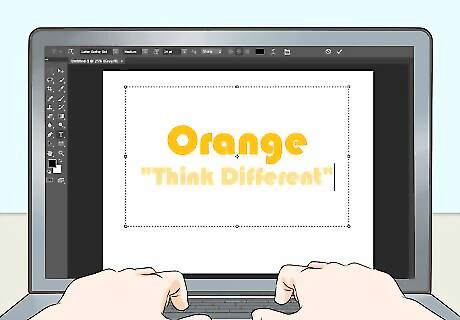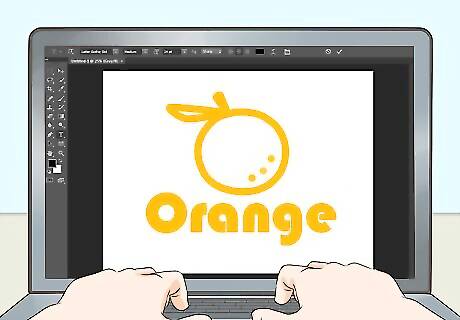
views
Creating an Authentic Look and Message

Pinpoint your mission. What are qualities, values, and experiences are you going to offer your customers? To make your brand seem authentic and efficient, you need to project a truthful image of what your brand strives to provide. Before you can do that, it’s important to articulate your company’s mission so that you’re clear on what sets you apart from other competitors. Think about the following questions: Why did you start this business? What are the goals you want to achieve? Who are the people you want to provide a solution to? What makes your company unique among others?

You have to decide how you want to be seen. In each step of your business, create a positive impression for customers to think of your brand almost like a living and breathing person they can trust. Emotionally, they need to feel that your brand is the one they should turn to when they are in need. Taking your mission into account, decide what type of attitude you want to project. What spin are you going to put on your mission? Maybe you want your product to be seen as the ticket to an adventure or a brand new life or a second chance at youth. This approach is often taken by upscale food companies that sell products like goji berry juice or sprouted grain granola bars. Maybe you want to present your brand as smart and cutting edge. Being seen with your product will make customers feel cool like they’re in a special club. Brands like Urban Outfitters and Apple take this approach. Another approach would be offering your customers a reliable, completely trustworthy option that will never let them down. This is a good approach if you’re selling a product that should never malfunction, like tires, or if you’re building a brand for your law practice. You could also rely on nostalgia to build your brand. People feel connected to things that remind them of childhood and carefree times.

Think from the customer's perspective. When you buy a product, why do you buy it? What makes you choose a particular brand? See if you can use your answer to help you figure out how your own brand will come across. Find out what your customers are longing to feel and make your brand help them feel that way. Do they want to feel powerful? Responsible? Conscientious? Smart? Unique? Your brand needs to evoke this feeling with all of its copy, marketing, and design. Cue these feelings not only with language but with colors and product design as well. Basically, you want to think about who you're trying to reach. Who is your market? What do they tend to enjoy hearing or seeing in other brands that they like? According to brand name psychology, when customers hear your brand name for the first time, they receive a set of images, feelings, or even a storyline that triggers them emotionally to engage with your brand. According to research and studies, most of the decisions made by customers are based on these emotions rather than being rational.

Refine your brand language. Choose a perfect brand name, a catchphrase or slogan and some keywords that you want to be associated with your branding strategies. The words should be closely aligned with your mission statement, make sense for customers, and be memorable enough to recall whenever needed. Use your brand language not only in the copy of your products and advertising but also when you discuss your business and make contacts in person. Keep your text as streamlined and basic as you can because it is more memorable that way. A good example of this was the tagline Apple was using for much of the '90s and into the 2000s: "Think Different". This worked on multiple levels, because it painted the brand as smart and unique, and the concept was easily slipped into discussions and other branding platforms. Two words: ingeniously effective branding. All copy associated with your brand, including what appears on your product’s label, on your website, and in advertising materials, should match the tone you’re trying to project. For example, your company is meant to be seen as trustworthy and comfortably old-fashioned, use slightly formal language that will make your customers feel that the people who run your business are as dependable as their third-grade teacher.

Choose a design scheme. Your brand needs a look that’s in keeping with the tone of your brand mission and language. Are you modern and sleek? Fun and colorful? Traditional and classic? This look should be synchronized across all of your media (brochures, website, product, offices, etc.). Design a great logo. Rather than representing your brand, your logo is useful to help embed your brand in your customer's right side of the brain. For example, when someone sees a checkmark, they remember Nike, even if there is no other clue that represents Nike. Your logo must be well designed by a professional and you should use it frequently and place it prominently. Choose the colors that will represent your brand wisely. These colors will be used as often as possible on promotional materials to help evoke your brand. Examples include McDonald's gold and red, Google's red, yellow, green, and blue, or wikiHow's green and white. Remember to keep both your brand name and logo simple. You want your brand to be easily recognized and unforgettable. The best way to do that is to be unique and simple. You might want to get legal protection for your visual branding and any distinctive phrases you use to describe your business or your offer.

Involve your employees. Communicate the importance of your brand to your employees and explain why and how you arrived at the brand identity you are promoting. You will need their support for your new branding to be effective. Remember that everything your business does is linked to your brand in the eyes of the customer. Even the way your employees dress and behave. Your employees may have their own image of your business. They'll have ideas about what your business stands for, and whether it is delivering on its promises. Employees can provide invaluable insights along the way. Ask your employees how they believe your product or service is being received on the market and don’t discount their opinions.
Gaining Customer Loyalty

Back up your message with a great product or service. If your messaging sounds good but you don’t deliver on your promises, your customers will go elsewhere, and your brand won’t catch on. If your brand delivers exactly what it promises, you’ll easily gain your customers’ trust. Before long, they’ll start spreading the word about your quality of service, and your brand’s reputation will soon speak for itself. Make sure that your customers’ association with your brand lines up with what you’re offering, too. For example, if you promise that your margarita-flavored lemonade is the most refreshing drink on the market, but your customers routinely complain that they took a sip and were surprised it didn’t contain tequila, there’s something off about the way you’re pitching the product. You have to rename the drink so that your customers don’t feel let down or tricked when they are trying your product. Being transparent about your business practices is essential, too. Trust is a really important part of brand recognition because your customers need to feel like they know your brand perfectly well. Let your customers see how you work, how you care about them, and what your real priorities are in business. Even if the information isn't always the best, it should at least be true and painted in the best possible light.

Conduct market research to find out who you’re serving. What's the age group and demographic of your main customer base? You might be surprised at the answer, so it’s important to conduct some research to find out who’s interested in the product you’re offering, and how they’re responding to your branding. Consider running a focus group so you can test out how your product is received by people from different demographics. Ask them to describe their perception of your product before and after trying it. Targeting a specific demographic is often more effective than trying to be universally appealing. You might find that you’ll decide to narrow your focus after learning who’s buying your product. For example, if you find that teenage boys are the most likely group to buy your snack mix, you may want to change your branding strategy to make your product even more appealing to this demographic.

Do a competitive analysis. Conduct research to find out what your competitors are offering, their strengths, and weaknesses as well. Then you can decide how your company should be better and unique among them. Your branding should focus on the difference, on what makes your product better than the rest. Finding that special something that sets you apart is essential, because your customers have so many choices that they’ll never even know your product exists unless you help it stand out. You might find that a certain company has already cornered a particular segment of the market, but that doesn’t mean that your product won’t appeal to a slightly different demographic. If you find that the market is saturated with great products, consider pivoting in a different direction. Either change your branding approach or tweak your product.

Talk with your customers. It’s important to interact with the people who buy your product. Not only will they give you essential feedback on how your business could improve, but it’s a way for them to feel that they know your brand and what it stands for. Represent your brand's values in how you talk and how you act. And constantly give your customers the freedom to give feedback and ask questions so that they get the chance to become familiar and eventually trust your brand as potential customers. Respond promptly to feedback when you receive it. If someone complains, make sure to hear him or her out with care and respect and resolve the issue to address the person’s concerns. Most importantly, do not ignore the negative feedback. Avoid using automatic replies to emails. Try to make your business seem as personable and friendly as you can. Let your customers see your enthusiasm and your level of caring for them.
Promoting Your Brand

Develop a marketing strategy. Have a plan in place to get your brand name in as many stores and in front of as many people as possible. Depending on the product or service you’re offering, you might want to consider taking out ads online, in newspapers, in magazines, and wherever you might find new customers. Apply your branding, including your visual brand and brand messages, to all of your materials—from packaging, signage, and stationery, to your website and marketing materials. Don’t be shy about boldly branding your products and displaying them in as many venues as possible. You want your brand to be everywhere people look. Advertise your brand in unexpected places. Radio advertisements, employee uniforms, and freebies with logos (such as tissues or pens) are all relatively inexpensive yet creative ways to promote your brand. See if you can get publicity from a local newspaper, TV station, or a blog that will review your product or service.

Have a presence on social media. Social media presence is one of the best methods to build up a potential brand these days. Get basic but relevant social media accounts and update them regularly with pictures, deals, and other information about your brand. Find things that are related and appeal to your customers and give them the chance to interact. For example, if you're a travel company, you can post a picture of a beautiful location with a catchy message like: "Counting down the weeks to summer vacation and some time to unwind! Where do you want to travel this year?" Do not become spam. Avoid constantly pushing your brand in an annoying way or without context or to people that have no interest. Stay out of your customer's recycle bins. Be real and conversational, not a metaphorical sleazy car salesman. Gigi Hadid Gigi Hadid, Model & Fashion Influencer Build your personal brand on social media. "I feel lucky to live in the era of social media and be a working model in this time. Back in the day, models were just another face, but social media has given people a voice. You can show the world your personality."

Have a killer website. This is the age of the Internet and social media, so having a website is central to building a sustainable brand. It's fine to base your business in the flesh and traditional media, but if you don't at least have a website, you'll be seen as old-fashioned and inaccessible. Hire a professional or use a template to come up with a nice-looking website. This should, at a minimum, discuss what your brand is about, where your offices can be found, what your hours are, and how you can be contacted. Use your site as an opportunity to tell your story with pride. People have an easier time understanding something that fits into a story, and they'll especially identify with things that let them feel like they're a part of that story. Give your customers a story that they can be a part of if you want to build your brand into a big name. Publish it on your website’s “about” page or distribute it in your publicity materials. For example, in the '80s and '90s, Microsoft painted themselves as a company that pulled themselves up by their bootstraps in order to become the most innovative and effective product in their field. This resonated with business-oriented individuals, who wanted to see their own lives in the same way and who could feel a part of that spirit of greatness by buying Microsoft products.

Be involved in the community. Having an in-person presence helps to build trust and spread the word about your brand. Throw events, attend events put on by others, do volunteer work, and be civically active. This is a great way for your customers and potential customers to see what your brand stands for. Street fairs and other daytime events often provide opportunities for businesses to set up a table and hand out information. Take advantage of this opportunity to forge bonds with people in your community who could potentially be customers. Giving back to your community through donations and sponsorships is another good way to get your brand out there. You could sponsor a little league team or a girl scout troop to build up your community presence.




















Comments
0 comment